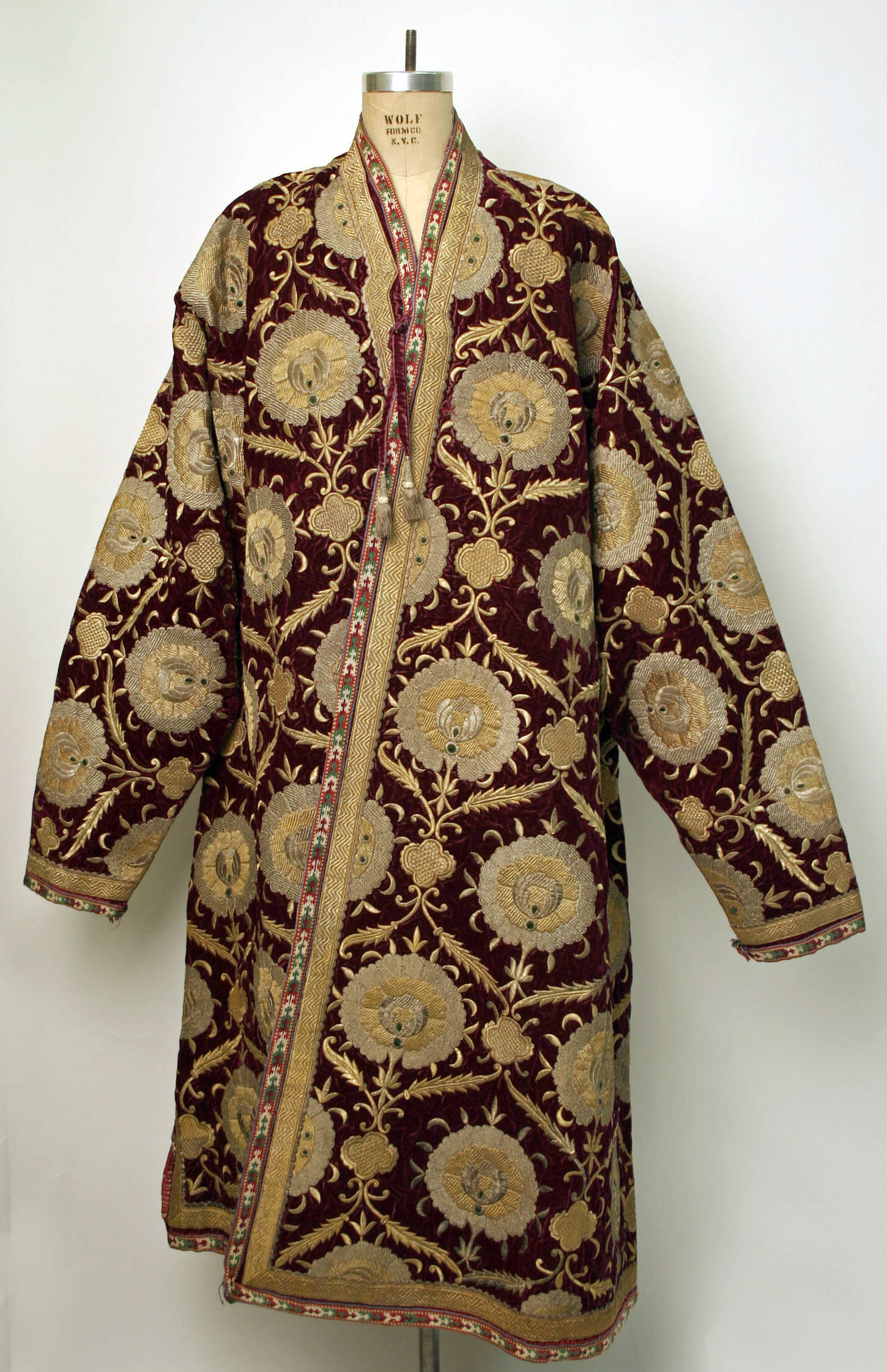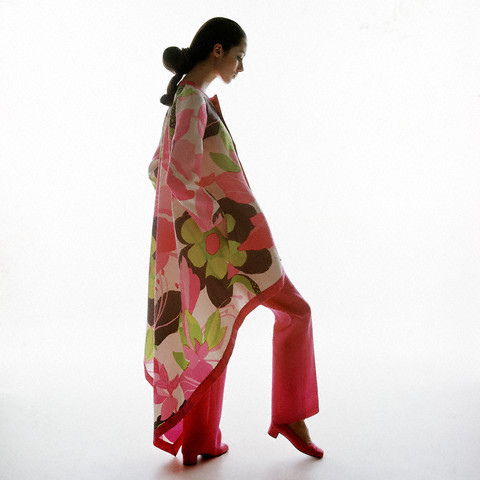A Brief and Opinionated Survey of the Caftan

by Sandy Vrooman, First published for the January/February 2011 issue of Finery

In the beginning, we wore clothing simply to survive. We wrapped ourselves in skins. Eventually, we learned how to tie them together, and weave. For the first modifications, we made a hole in a garment to slip it over the head and around the neck. Next maybe we tied it with a strip of animal skin to make the first belt. The poncho would be the modern equivalent of this, among many garments in modern use that have their origins from such early fashion statements.
The caftan (or kaftan) is another example of an early apparel construct. We hadn’t yet thought of cutting in curves, so such primitive caftans all had straight seams. Also, the concept of scrap fabric was probably considered wasteful because of the difficulty of obtaining cloth. Starting in ancient Mesopotamia and Asia Minor around 600 BC, variations of the caftan spread through Eastern Europe and Russia, and then Turkey.
When the Turks invaded Europe, the caftan-style garments made their way to Hungary and Poland. Similar garments can be found all the way from Africa to China with a stopover as the medieval chemise. Look at Folkwear 105 Syrian Dress to study the lines of caftan garments in use today, and compare them with those in the article at: http://www.marquise.de/en/1700/howto/frauen/18chemise.shtml , which shows diagrams on how to make a medieval chemise.
There are many names used for caftan with its wide center panel, narrow, tapered side panels, straight sleeves and perhaps a gusset under the arms. This style of garment, also called the kaftan, (boubou, kameeze (chemise?), abaya, etc.) reached its height of development during the Ottoman Empire, which lasted 624 years from 1299 to 1923 and occupied Asia Minor, Macedonia, Hungary and across North Africa to from Egypt to Tunisia. The Ottoman Turks developed men’s and women’s styles for their caftan garments, as well as styles designating status up to those of the Sultan himself.
How do you take a utilitarian garment and make it fit for a Sultan…and only a Sultan? The Turks achieved this by the use of rich fabrics, lavish embellishment and laws governing consumption. These sumptuary laws were introduced for many reasons, some religious and some hierarchal. When the feudal system started to break down, a moneyed merchant class formed. If the merchant class could afford to wear the same garments as kings and clergy, where would it all stop? It was this type of law that declared purple as a color to be worn only by royals. Religious communities used sumptuary laws to maintain a sense of humility before the Lord, and suppress vanity. As another example, only the Sultan was allowed to wear certain fabrics and decorations. The variations in embellishment were spelled out in the law. Some were suitable as gifts of honor. Some were designed for the royal household and identically trimmed garments could denote a specific serving class.
These designations in styles extended to military uniforms. To this day, the national Algerian costume for men reflects the garments worn by the Janissaries, the Sultan’s elite fighting force. Folkwear 501 Algerian Suit shows this design. The Topkapi Museum in Istanbul has a collection of ceremonial caftans on display, each a marvel to behold, as if each successive garment tried to upstage the last.
Perhaps because of the Silk Road trade routes used to obtain these rich fabrics, one can’t help but notice the similarities between the Turkish Sultan caftans and the Chinese royal robes, echoed again in some Russian royal garments. Many of the robes worn by clergy today still echo these early garments.
The history of the Silk Road deserves its own article. It is actually many trails across two very inhospitable deserts that followed a string of viable oases. The western development of the route was started by the Persians about 300 BC, conquered by Alexander the Great and maintained by a continuing line of conquerors and countries. It was at its height during Tang Dynasty in the 7th century and began its demise in the 11th century at the end of the Khan rule.
There have always been those adventurous souls who had to see what was over the hill or in the next valley. Marco Polo, despite being the best noted trader of his time, did not establish trade with the mysterious East, but hacked the stories told to him while in prison with other folks who dared to step outside the systems where they lived. One of the easiest things to bring back from such a journey was that magical fabric called silk. As capital increased due of sale of these treasures, the list of imports expanded to include ivory, gold, exotic plants and animals. There was also a trade that involved the spread of Buddhism.
We still wear caftans. They returned to popularity in the 1970’s as a fashion statement, and continue as a practical garment for wear in the desert. One might think of desert wear as a light weight, light colored garment. Perhaps for indoors, but covering up in a heavy garment of black or actually indigo is what you will find. As a heavy garment keeps out the cold, it also keeps out the intense heat. Moisture is kept closer to the body instead of evaporating. Do you know that you do not feel perspiration in the Sahara until the night when the temperatures drop enough so that perspiration does not immediately evaporate? The billowing quality of the garment allows the motion of air giving the feeling of a cooling effect. This same phenomenon is achieved when a bunch of four-sided pointed tents are grouped together. The hot air rises up to the top and is felt as a cooling breeze in descent from one tent into another.
The other question we might ask is “why black?” It’s not really black but indigo, and is believed to have curative powers. The Griot actually rub newly dyed indigo fabric over their skin, giving them the nickname “the blue people”. When I was adopted, briefly, into a tribe in Mauritania, I was painted blue. They told me if you fell down in the desert wearing white, you would soon blend with the sand, but a black lump would be spotted more quickly. Is there still a class distinction in clothing today? Not by law; sumptuary laws are no longer enforced. But if you can afford a garment you might wear once, whose value could feed a small village for a week, aren’t you showing you have the privilege to do so?




Leave a comment